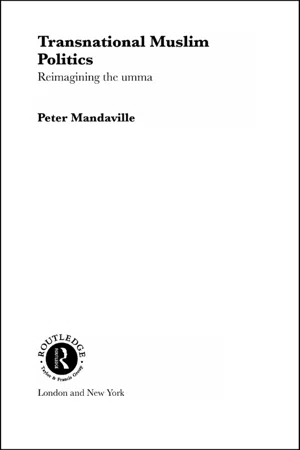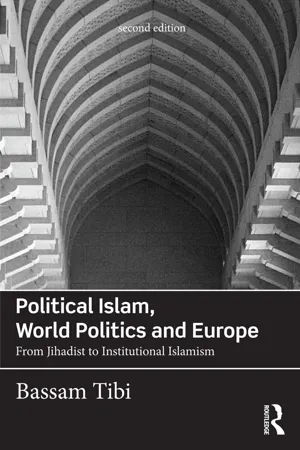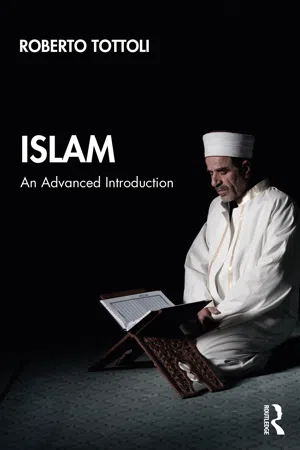History
Dar al Islam
Dar al Islam refers to the lands where Islam is the dominant religion and where Islamic law is practiced. It encompasses regions where Muslims have established political and cultural dominance, and it is often associated with the spread of Islamic civilization. The concept of Dar al Islam has been significant in shaping the historical and geopolitical landscape of the Islamic world.
Written by Perlego with AI-assistance
Related key terms
3 Key excerpts on "Dar al Islam"
- eBook - ePub
Transnational Muslim Politics
Reimagining the Umma
- Peter G. Mandaville(Author)
- 2003(Publication Date)
- Routledge(Publisher)
dār al-’ahd (the domain of treaty). This represents a region in which Muslims and non-Muslims have entered into some form of agreement as regards the conduct of relations between them, usually to the greater benefit of the Muslims by way of a tributary tax exacted from nonMuslim communities. This latter category, however, has not appeared in Muslim writing with anything like the frequency of the first two.It is not surprising that these terms have been deployed most frequently during times of perceived conflict between Muslims and non-Muslims. The colonial era marked one such period. The notion that the West was somehow a land of unbelief which might one day be brought under Islamic rule found particular resonance in the colonised imaginations of the Middle East, India and Southeast Asia. At that time it was perhaps one of the clearest Manichean expressions of the global situation. There was clearly an ‘us’ (those Muslims ruled by colonial Europe) and also a ‘them’ (the colonising powers who would themselves one day be subject to Muslim rule), dar al-islam, dar al-harb. Such notions also exercised the minds of Muslim political theorists in the early years of decolonisation, forming the basis of programmes - such as Sayyid Qutb’s (see Chapter Two ) - seeking to depict the depravity and corruption of the West.Although many of the more radical Islamist tendencies today (such as Hizb ut-Tahrir and al-Muhajiroun) still use this vocabulary in its traditional idiom, there is also a sense in which we can argue that concepts such as dar al-harb and dar al-islam are currently undergoing certain transformations. Broadly, this rethinking of political community is taking two forms. First, there are those Muslim thinkers seeking to apply the label dar al-harb to their own Muslim majority states. The argument here is that none of these governments is ‘truly Islamic’ and hence cannot be seen as dar al-islam. Classical Islamic law requires Muslims to depart from any Islamic state which lapses into dar al-harb; hence the connection with diaspora. Many of the political activists who criticise their governments in this manner end up as exiles in London or Paris. The Islamic opposition in the Arabian Peninsula is a prime example of this trend. The second way in which these categories are changing relates to the reformulation of dar al-islam. There are those theorists who wish to claim that the only requirement for a country to qualify as dar al-islam is that Muslims must be allowed to practise their religion with complete freedom. Some writers also emphasise the extent to which Muslims are actually more often able to fulfil the scriptural obligations of their religion in the West than they are in their own countries.147 There have even been those who have suggested that because there is no such thing as a true dar al-islam then there is also no such thing as dar al- harb because they are necessarily always defined in opposition to each other; without one, the other does not exist.148 - eBook - ePub
Political Islam, World Politics and Europe
From Jihadist to Institutional Islamism
- Bassam Tibi(Author)
- 2014(Publication Date)
- Routledge(Publisher)
qital . This is a reinvention of the classical Islamic concept of peace, attached to a new doctrine of jihadism and becoming a mobilizatory ideology in the service of jihadist Islamism. Having clarified the terms under issue, we now have to go back to history in order to understand the present.The context and the sources of jihad, past and present
In classical Islam the concept of jihad is based on ethical foundations. The Islamic tradition of jihad legitimates waging war, although clearly for ethical reasons, and it determines the rules for its conduct as an Islamic ethics of war (see note 3 ). Jihad is among the basic beliefs underlying the Islamic worldview as a Weltanschauung that seems to be resistant to change6 because it is believed to be immutable as it was revealed by Allah. However, the real world is in flux and keeps changing, to the extent that the believed and text-based dichotomy that divides the world in a rival Islamic and a non-Islamic territoriality is no longer a reality of our world in the twenty-first century. In ignoring the realities, jihadists revive the jihad in a new meaning, abandoning the perceived dichotomy through establishing an Islamic peace uniting the world under the banner of Islam.7 In this perception imagination and realities are confused with one another. What origins do these concepts have in the basic scriptures of Islam, the Qur’an and the hadith ? And what is their pertinence to the present?Islamic thinking on war and peace mostly refers to the Qur’an and to the authoritative interpretations of Islamic tradition. Of course, there are basic differences between Sunni Islam, as the expression of the major stream in Islam, and Shi’ite Islam, represented by a sectarian minority in Islam. These differences are crucial in our present examination of the transformation of classical jihad into a jihadist internationalism. This contemporary manifestation of transnational religion is extremely important and is the subject of Part II - eBook - ePub
Islam
An Advanced Introduction
- Roberto Tottoli(Author)
- 2020(Publication Date)
- Routledge(Publisher)
wa (“propaganda”) and the spread of Ismailism beyond Egypt, although they made no great efforts to proselytise in the territories under their control.There have always been dynasties asserting their legitimacy on the basis of their religious aptitude, throughout the history of the Islamic world. Indeed, the religious and eschatological vision is precisely connoted on this basis, above all in the history of early Islam and for the realisation on earth of the ideal Muslim society of Medina. There is no room in the Muslim order for limited or alternative forms of sacredness, for everything comes within the order decreed by God. This, of course, is the religious ideal, but the political realities have always been somewhat different, action not always being dictated by religious considerations, or at least not directly associated with traditional ideals. Consequently, strife and conflict have always seen political use of a specific vision of Islam in history, without, however, entailing the theorisation of separation or secularism that emerged from the tragic events marking modern Europe.The whole question of authority and the role of religion in defining it have thus been constant factors, with decidedly diverse criteria frequently giving rise to clashes within the Muslim world. An ideal of unity and positive radiation has always offered inspiration in achieving the greatest good for the human community, with the confidence that the ideal was destined eventually to become fully functional, albeit perhaps only through eschatological time. From this point of view there was little difference between the Shi‘a and Sunni currents, over and above the concrete manifestations in particular times and places. If the Imam was hidden for some, the caliph, as a figure of ideal Sunni leadership in the community of believers, did not last much longer.
Learn about this page
Index pages curate the most relevant extracts from our library of academic textbooks. They’ve been created using an in-house natural language model (NLM), each adding context and meaning to key research topics.


